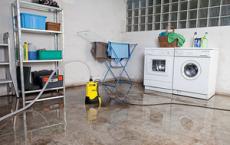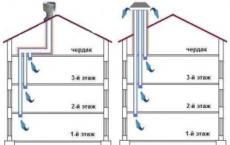Heating of the double-circuit boiler of the wall diagram. Gas heating of a private house: circuits, device options, review of the best solutions
If the construction project is only being developed, then choose suitable option heating the house is easier. Of course, you need to take into account the region, the availability of the most affordable fuel, the number of floors in the house, the degree of insulation and some other factors that are specified after the thermal calculations. But to choose the options for heating a private house of an existing one is a bit more complicated. In this case, it is more often a question of replacing obsolete or unprofitable heating with another type of heating. At the same time, the following types of private house heating systems and their popular options are possible:

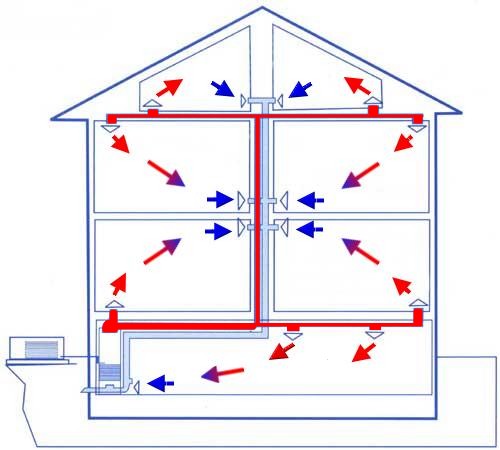 Used for heating is designed and installed during the construction of the house. The variant is very expensive, and for existing premises it is difficult to mount it. We will not delve into the consideration of expensive exotic systems and consider the available and popular types of heating for private dwellings.
Used for heating is designed and installed during the construction of the house. The variant is very expensive, and for existing premises it is difficult to mount it. We will not delve into the consideration of expensive exotic systems and consider the available and popular types of heating for private dwellings.
 In the presence of gas main scheme of gas heating private house is the most optimal. In this scheme, a gas boiler is installed as a heat generator, which heats the heat carrier. The motion of the coolant takes place either by gravity (gravity systems) or by means of a circulation pump. For small private houses, schemes for heating a private house with a wall boiler are used successfully, if there is no separate room for the boiler room, and the dimensions of the kitchen are limited.
In the presence of gas main scheme of gas heating private house is the most optimal. In this scheme, a gas boiler is installed as a heat generator, which heats the heat carrier. The motion of the coolant takes place either by gravity (gravity systems) or by means of a circulation pump. For small private houses, schemes for heating a private house with a wall boiler are used successfully, if there is no separate room for the boiler room, and the dimensions of the kitchen are limited.
The piping layouts are standard: 
- single-tube;
- two-pipe.
Single-pipe circuit
 Single-pipe system with a series connection of radiators is used only in small houses or cottages. This wiring diagram has a significant drawback - uneven heating of the batteries, which is especially felt if the scheme of heating a private house without a pump, which is called "gravity flow", is mounted. If the length of the contour is small, then almost completely compensates for this shortcoming. With a large number of batteries and a considerable length of the circuit, a modernized single-pipe system is used - "Leningrad". It was invented in Leningrad - the present St. Petersburg.
Single-pipe system with a series connection of radiators is used only in small houses or cottages. This wiring diagram has a significant drawback - uneven heating of the batteries, which is especially felt if the scheme of heating a private house without a pump, which is called "gravity flow", is mounted. If the length of the contour is small, then almost completely compensates for this shortcoming. With a large number of batteries and a considerable length of the circuit, a modernized single-pipe system is used - "Leningrad". It was invented in Leningrad - the present St. Petersburg.
Two-pipe circuit
![]() The two-pipe scheme of connecting a gas boiler in a private house is the most optimal in terms of uniformity of heating even when using a "gravity system", but more material-intensive. In this scheme, the coolant flows to the batteries through a supply pipe, and returns to the other, which is called a "return". All heating devices are connected to these two pipes in parallel, which facilitates the repair and temperature control in various rooms.
The two-pipe scheme of connecting a gas boiler in a private house is the most optimal in terms of uniformity of heating even when using a "gravity system", but more material-intensive. In this scheme, the coolant flows to the batteries through a supply pipe, and returns to the other, which is called a "return". All heating devices are connected to these two pipes in parallel, which facilitates the repair and temperature control in various rooms.
Radiatorless heating system
There is, still rarely used because of the high price, pipe heating without radiators in a private house used in the reconstruction or construction of a house. The floors are laid pipes of the contours of the warm floor and poured screed.
To create a radiator system, an integrated collector is installed, which is integral with the mixing unit.
In such a system, the temperature is controlled automatically and there is the possibility of remote control. Distribution manifolds there may be several, for each room. For small premises - a bath, a toilet, etc., a compact pump unit is used, for example, the Thermotech MINI350 with a built-in heater of 350 watts. With this device are implemented warm floors in small rooms. Such individual gas heating in a private house is extremely comfortable, but requiring significant financial costs.
Which pipes are better
 A scheme has been chosen, a boiler has been purchased and it is inevitable that you decide - which pipes to choose for heating a private house, plastic or metal. Pipes can be made of any material, but for heating, most often used are either metal or polypropylene reinforced pipes. Metal and plastic pipes have advantages and disadvantages.
A scheme has been chosen, a boiler has been purchased and it is inevitable that you decide - which pipes to choose for heating a private house, plastic or metal. Pipes can be made of any material, but for heating, most often used are either metal or polypropylene reinforced pipes. Metal and plastic pipes have advantages and disadvantages.
Metal pipes
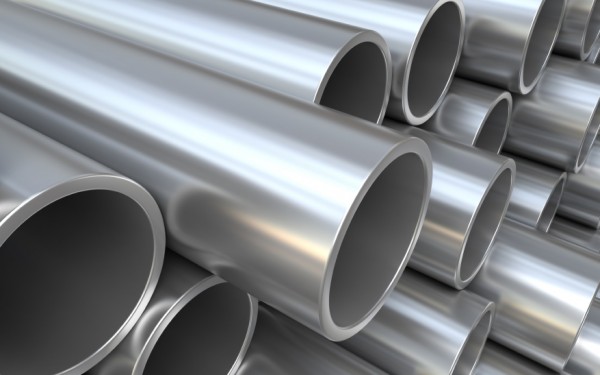 With the help of metal pipes, all the equipment for gas heating of a private house is combined - a boiler, radiators, expansion tank etc. Pipes made of steel are durable, but for welding it is necessary to use welding. Sometimes owners use threaded connections, but this is a very laborious method. are susceptible to corrosion and a sediment that gradually consists of rust and various contaminants gradually accumulates.
With the help of metal pipes, all the equipment for gas heating of a private house is combined - a boiler, radiators, expansion tank etc. Pipes made of steel are durable, but for welding it is necessary to use welding. Sometimes owners use threaded connections, but this is a very laborious method. are susceptible to corrosion and a sediment that gradually consists of rust and various contaminants gradually accumulates.
But they have undeniable advantages: 
- high rigidity, which allows you to install any slope with a minimum of fasteners;
- slight linear expansion;
- resistance to high temperatures, pressure and water hammers;
Metal-Plastic Pipes
Metal-plastic pipes are made of polyethylene. They consist of three layers. The middle layer is made of aluminum, and all three layers are firmly glued together. Aluminum increases stiffness and reduces the linear expansion of the pipe. The disadvantage can be considered high cost. To ensure that there are no leaks during operation, but you need to use high-quality metal fittings.
Polypropylene pipes
Boilers for individual heating
 Any gas system heating of a private house involves the installation of a boiler that uses gas to heat the coolant. If there is no natural gas, the heating circuit will provide a hot coolant to the gas boiler on propane, which is pumped into cylinders in a liquefied form. Products of the world's largest producer of gas equipment of the Japanese corporation "Rinnai" appeared on the market.
Any gas system heating of a private house involves the installation of a boiler that uses gas to heat the coolant. If there is no natural gas, the heating circuit will provide a hot coolant to the gas boiler on propane, which is pumped into cylinders in a liquefied form. Products of the world's largest producer of gas equipment of the Japanese corporation "Rinnai" appeared on the market.
 Unique Rinnai gas boilers are created using the most modern technologies. This wall-mounted turbocharged two-circuit boilers with an efficiency of 96% operate at low gas pressure, and the combustion process itself is electronically controlled by a special algorithm.
Unique Rinnai gas boilers are created using the most modern technologies. This wall-mounted turbocharged two-circuit boilers with an efficiency of 96% operate at low gas pressure, and the combustion process itself is electronically controlled by a special algorithm.
 Manufacturer of boilers Arderia company Daesung Inductry co. LTD in South Korea produces a gas boiler Arderia its price in rubles depends on the dollar exchange rate and is approximately 570 - 580 cu. The boiler is two-circuit, turbocharged, efficiency - 91.1%. The company produces single-circuit and two-circuit gas boilers the difference is that the dual-circuit boiler will provide the consumer hot water.
Manufacturer of boilers Arderia company Daesung Inductry co. LTD in South Korea produces a gas boiler Arderia its price in rubles depends on the dollar exchange rate and is approximately 570 - 580 cu. The boiler is two-circuit, turbocharged, efficiency - 91.1%. The company produces single-circuit and two-circuit gas boilers the difference is that the dual-circuit boiler will provide the consumer hot water.
Electric boilers for heating
The boiler of any system is a heat generator, it heats the coolant and feeds it to the circuit. In principle, any heating scheme can work with any type of boiler.
Very convenient are electric boilers for domestic heating, but they require the availability of sufficient power supply.
 Network supply to the boiler is usually done separately, with a cable with a cross-section of wires providing reliability and safety. The well-known German company VAILLANT produces not only high-quality gas boilers, but also the same-name electric boilers of various capacities. For example, wall, single-circuit from 560 cu. Its price is Vylant boiler is produced with different capacities.
Network supply to the boiler is usually done separately, with a cable with a cross-section of wires providing reliability and safety. The well-known German company VAILLANT produces not only high-quality gas boilers, but also the same-name electric boilers of various capacities. For example, wall, single-circuit from 560 cu. Its price is Vylant boiler is produced with different capacities.
Advantages of installing electric boilers for private houses:

Extractor in a private house
 For wall-mounted gas boilers that are equipped with open camera combustion, air in the chamber comes from the room. Therefore, such devices require equipment effective system ventilation. For safety, the kitchen in a private house with a gas boiler should be equipped with a hood. The air circulation in the cooker hood can be natural or forced. For forced drawing a special fan is installed.
For wall-mounted gas boilers that are equipped with open camera combustion, air in the chamber comes from the room. Therefore, such devices require equipment effective system ventilation. For safety, the kitchen in a private house with a gas boiler should be equipped with a hood. The air circulation in the cooker hood can be natural or forced. For forced drawing a special fan is installed.
The installed hood for a gas boiler in a private house creates good air exchange and the timely removal of harmful fumes.
 If the boiler is wall-mounted, the hood has a wall arrangement, and for floor boilers it is located near the floor. The diameter of the exhaust pipe should correspond to the size of the boiler outlet pipe. The connection of the chimney duct and the hood must be tight and reliable. The upper edge of the chimney must be located above the ridge of the roof. And parallel to the chimney is the ventilation duct.
If the boiler is wall-mounted, the hood has a wall arrangement, and for floor boilers it is located near the floor. The diameter of the exhaust pipe should correspond to the size of the boiler outlet pipe. The connection of the chimney duct and the hood must be tight and reliable. The upper edge of the chimney must be located above the ridge of the roof. And parallel to the chimney is the ventilation duct.
Heating batteries in a private house
For autonomous heating apply all known types  dy batteries. The use of this or that type of radiator is determined by the requirements for the design of the room and depends to a large extent on the financial possibilities.
dy batteries. The use of this or that type of radiator is determined by the requirements for the design of the room and depends to a large extent on the financial possibilities.
Batteries, if they are arranged in order of increasing prices, will be arranged as follows:
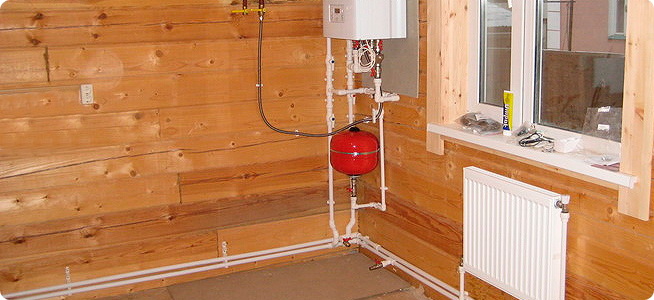
 For dachas and country houses, if no one lives permanently in them, it is necessary to drain the coolant to avoid defrosting the system. This circumstance limits the use of steel batteries, which in the absence of water will actively corrode.
For dachas and country houses, if no one lives permanently in them, it is necessary to drain the coolant to avoid defrosting the system. This circumstance limits the use of steel batteries, which in the absence of water will actively corrode.
Every owner should know which heating batteries are best for a country house or giving. You can install any, but taking into account the shortcomings of steel batteries. If the owner permanently lives in a country house, then he can install radiators which are suitable for the price and design.
The piping of the heating boiler is a system of pipelines and equipment designed to provide coolant to the radiators. Simply put, it's everything, except for batteries. Do not be afraid of the abundance of pipes, devices and technological stages. After reading the article you will be able to work this job. And if the heating boiler itself is arranged, then it will serve longer, and it will take less money.
The first step is the selection of a heating boiler, the performance of which must be determined beforehand.
The calculation of the required capacity of the heating unit is affected by many factors, such as:
- the volume of the building;
- the number of windows and the total area of the glazing;
- number and area of doorways;
- thermal conductivity of materials used in the construction of walls;
- degree of insulation of load-bearing structures;
- average annual temperature in the construction region;
- the location of the building, i. on which side of the world comes the main, traditionally the most glazed, facade.
However, there is an average indicator that, without in-depth calculations, allows you to determine the required performance. For the central band for the starting point (but not the guide to action!), You can take 1 kW per 10 m² of heated area. To the calculated capacity of the boiler, it is necessary to add a stock of at least 20%.
Heat for heating buildings is obtained by processing fuel in boilers heating the coolant
Types of heating boilers
Conditionally the heating boilers can be divided into autonomous and manual loading.
Autonomous boilers, depending on the fuel used, are:
- solid fuel;
- electric;
- gas;
- oil-fired.
The order in the list determines the cost of heating, depending on the type of fuel: gas boilers will be the cheapest in operation. Boilers are equipped with automatic control of the set temperature of the coolant. Can work all year round all life time. There are wall-mounted and floor-standing.
Image Gallery








Boilers for manual loading include boilers for solid fuels. As fuel used wood, peat, coal. Require the participation of a person to load fuel. Maintaining the right temperature of the coolant is also a part of the person's responsibility. Execution of boilers - outdoor. Equipped with a minimum set of automatics. Heating boilers they are one- and two-contour ones. A double-circuit boiler is connected with a water pipe, which is constructed for heating hot water.

Heating systems with a heating boiler should provide the necessary temperature in the treated premises. The strapping scheme should be oriented to the uniformity of heat supply to all devices
Independent heating boilers and the principle of operation
In most modern gas boilers for autonomous heating, the temperature of the coolant is maintained automatically. Inside the unit there is a heat exchanger heated by a burner on liquid or gaseous fuel. The boiler's thermal sensor constantly monitors the temperature of the coolant.
As soon as the temperature has reached the preset level, the burner dries and the heating stops. If the coolant temperature falls below the set limit, the burner is ignited again. Such ignition-damping cycles can occur quite often, there is nothing wrong with that.

If you plan to install a heating system with high capacity, then there is a possibility of overheating of the coolant. In such schemes of strapping, it is necessary to provide a thermal accumulator
The vast majority of installed heating boilers heat the coolant by processing gas or liquid fuels. This is facilitated by ubiquitous gasification and high reliability of boilers.

In the schemes of tying with solid fuel boilers, there is no provision for the regulation of the heat supply, the burning process can not be controlled. If the combustion stops, the circulation pump stops (click to enlarge)
Pros of gas and liquid fuel boilers:
- ease of maintenance;
- a lot of security systems, often duplicating;
- part of the equipment is included (circulation pump, manometer).
Unconditional dignity is a high efficiency, which on average is 98%.

For heating systems, water can circulate at a temperature of no more than 105 ° C, steam heated to 130 ° C or air up to 60 ° C. When the operating parameters are exceeded, the safety group
There are also disadvantages:
- in the absence of electricity, the whole system stops, a threat of defrosting is created;
- high price;
- the circulation pump works around the clock;
- can only be used in closed systemsoh.
When installing an autonomous boiler, you need to consider the constant costs of electricity. The circulation pump runs continuously, regardless of whether the coolant is heated or not.
Solid fuel boilers for manual loading
AT solid fuel boilers loading and ignition of fuel occurs manually. The combustion intensity can be adjusted in a limited range. The operating time is determined by the burning time of the fuel of one load.
Solid-fuel boilers are the most universal solution, their advantages include:
- independence from electricity;
- can be used in closed and open systems;
- low price.
Units of this type work on the most affordable form of fuel.
There are significant disadvantages:
- as a rule, are delivered with a minimum set of equipment;
- require constant monitoring by a person;
- have a low efficiency.
For the solution of traditional "winter" problems one of the options may be the use in one heating circuit of two boilers of different types. In the normal mode, an autonomous boiler operates, and in the event of an accident on a gas or electric line, a solid fuel heating unit is manually started.
Such a scheme will not allow the heating system to sub-cool and freeze. The second option, maybe the use of a special, non-freezing coolant - antifreeze.
From the type of heating unit depends largely on the choice of scheme for tying the boiler heating.
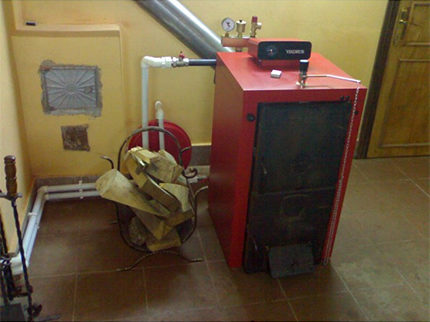
When installing a solid fuel boiler it is very important to observe all the distances from the walls
Types and schemes of heating
The purpose of the heating system is to transfer heat from the boiler to the radiators. The energy is transferred through the circulation of the coolant.
The heating circuit can be realized in the following ways:
- open one-pipe circuit;
- closed one-pipe circuit;
- closed two-pipe circuit.
Two-pipe closed heating circuit is the most progressive, has the highest efficiency. However, it is the most expensive and difficult to implement.
When heated, the heating system increases the volume of the coolant, the excess coolant is collected in the expansion tank. During cooling, the reverse process occurs: the heat carrier decreases in volume, the heating system draws the coolant from the expansion tank. By the way the organization of the expansion tank, the system is divided into open and closed.
Open circuit of the heating system
When open system the expansion tank is open, freely communicates with the atmosphere. The general arrangement is as follows: the heating boiler is located at the lowest point, the expansion tank is in the uppermost, with respect to the radiator. The greater the difference in the height of the expansion tank and the uppermost radiator, the better.
Image Gallery


![]()

Circulation of the coolant in an open single-tube system occurs naturally, heated water moves or its mixture with antifreeze due to gravity. Cooling the coolant becomes heavier, because of which it gradually descends to the lower level of the system. Heavy substance is pushing out a lighter, hot coolant. So they constantly alternate, i.e. the coolant moves along the ring heating system.

The boiler's piping scheme in the open heating system does not require the mandatory installation of control devices. In case of overheating, it will spontaneously get rid of the excess heat carrier (click to enlarge)
Such an organization of the heating system has its advantages:
- the most simple circuit;
- there is no need for electricity, because the coolant moves by gravity;
- weak sensitivity to emergency pressure increase (for example, when boiling).
The device of the system with natural movement of the coolant will need the least amount of money, because it makes no sense to equip it with automation, bypass valves, a circulation pump.
Unfortunately, there are significant drawbacks:
- constant contact of the coolant with air, leads to gas contamination;
- the possibility of cooling the coolant in frost;
- relatively slow circulation of the coolant;
- it is impossible to achieve the same temperature of the radiators;
- a large volume of coolant is required.
With an open system, the constant contact of the coolant with atmospheric oxygen leads to increased corrosion of pipelines and radiators. The formation of various contaminants reduces the efficiency of the heating system in general.
With aluminum and bimetal radiators, this system works poorly.
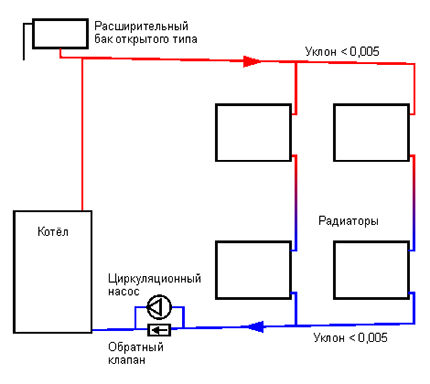
With a flow system with natural circulation it is important to follow the biases. The expansion tank is at the highest point of the system
An open single-pipe heating system is the easiest to implement and the least efficient. It is used with manual loading boilers. It is used, mainly, for heating small private buildings in one two floors.
Closed circuit heating system
When closed circuit heating system expansion tank is made in the form of a steel container inside which is a rubber pear or membrane under the pressure of air. With the expansion of the coolant, the pear shrinks and releases additional volume.
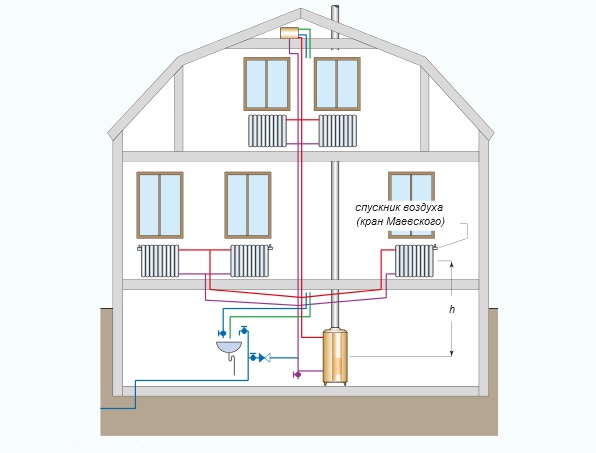
In a closed heating system, the excess pressure when the coolant is overheated is removed using a Mayevsky crane
Compulsory circulation of the coolant makes it possible to heat up all radiators faster and more evenly. In this case, the coolant by means of special air vent valves once again gets rid of all the gases in it. Pipelines remain clean and corrosion does not occur.
Image Gallery
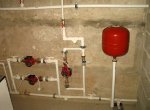

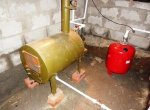

The layout of the boiler and the expansion tank can be any: the boiler can be located in the basement or on the first floor. Expansion tank, as a rule, is installed next to the boiler.
The advantages of a closed system:
- clean heat carrier;
- guaranteed circulation
- free arrangement of equipment;
- the minimum amount of coolant;
- small diameter of pipelines.
Disadvantages of a closed system:
- constant overpressure;
- increased cost.
A closed, single-pipe heating system remains, quite inexpensive, allowing the use of all types of boilers.

With the heating system closed, there is freedom of installation. The expansion tank can be next to the boiler
Single-pipe heating system
By the way the coolant moves along the pipeline scheme and the devices included in it, the heating systems are divided into one- and two-pipe systems.
With a single-pipe heating system, the main line of a large diameter - the feed - extends from the boiler. She acts as a transporter of the hot coolant and its collector in a cooled form. The radiators are connected in series to the pipeline by two thinner pipes. One of them takes the coolant, the other lets out.
The heat carrier alternately passes all the batteries, parting along the way with a part of the thermal energy.
- Flowing. In the flow diagram there is no feeder riser as a structural element. The radiators of the upper floor are connected to the analogues on the lower floor. In this scheme, you can not use adjusting cranes to not block the access of the coolant to the following devices.
- With bypasses. According to this variant, the radiators are connected by risers, but are separated from the contour by the closing links. The coolant comes from the supply pipe. Distributed by portions of all devices, which comes in almost at the same time, so that it cools less.
The heating circuit with bypass allows you to adjust the temperature and repair the failed device without disconnecting the entire system. In this respect, the flow variant loses the same way as the coolant cooling rate. But a flowing variety is easier to implement.

AT single-pipe systemsoh with forced circulation The heated coolant rises on the main riser and is distributed over the series-connected batteries
If a single-pipe circuit is used in a heating circuit with a natural coolant circulation, there are no return risers at all, and only the top wiring is used to connect the devices.
With a two-pipe heating system, one pipeline supplies a hot heat carrier heated by the boiler. The second - takes and takes it in a cooled form back to the heating unit. The receiving pipe is called the feed, the collecting pipe is called the return flow. The heating radiators are connected in parallel.
The coolant in the coldest radiator has the lowest temperature, accordingly it is stronger than the rest of the pressure. The circulation of the heat carrier is the more intense, the greater the difference in temperature between the supply and the return connection. As a result, the cooler will warm up more quickly. Thus, the temperature in all devices connected to the same manifold is equalized.
Pluses for heating with two pipes:
- adjustment for the temperature parameters of one radiator does not affect the rest;
- hydrodynamic stability of the entire system;
- it is easy to connect devices for regulating the supply of hot water;
- all pipelines can be hidden in floors or walls;
- high speed and efficiency.
Two-pipe systems come with an upper and lower wiring, with dead-end and passing transportation of the coolant. There are with its natural movement and with forced circulation, stimulated by circulation pumping units.

The two-pipe heating system is more complicated and more expensive than the one-pipe system, but it significantly exceeds the level of comfort conditions (click to enlarge)
In circuits with natural circulation, the boiler is installed
Of the minuses, we can distinguish the following:
- double number of pipelines;
- relatively high price;
- need for the use of shut-off and control valves.
The two-pipe system, despite its complicated design, is the preferred solution, especially when used with autonomous boilers.
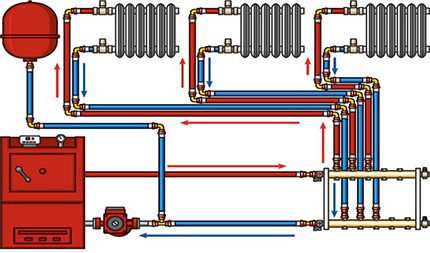
The heat carrier is disassembled from a pair of collectors
If you do not resort to complex heat engineering calculations, then you can take advantage of many years of experience in the construction in the middle lane. For the construction of the supply and collecting lines, it is recommended to use two-inch pipes (Ø 50mm) connected to the boilers. The sockets are made of pipes of the same size.
Depending on the number of sections, the batteries are connected to the supply and return of pipes by 1.5 "(by 25-35 sections), 1" (by 10-25 sections), 3/4 "(less than 10 sections).
When constructing an autonomous heating system with one or more boilers to achieve the greatest efficiency and comfortable microclimate, a two-pipe system is suitable. It can be used on any objects. Works with any type of radiators and any boiler. The selection of the heating scheme depends on the desired price-quality ratio and the purchased boiler.
Implementation of the heating system
Armed with the necessary knowledge of the principles and merits of each scheme of heating, you can make an order of actions:
- choice of the scheme of heating;
- selection of the heating boiler;
- acquiring necessary equipment;
- installation.
For the device open, single-pipe circuit heating, it is enough to have a thermometer (in most cases, comes with a boiler) and an expansion tank, usually homemade. For closed systems, the minimum necessary equipment is similar and discussed below.
Acquisition of necessary equipment
The mandatory list of equipment for closed heating systems includes:
- expansion tank;
- safety valve relief of overpressure;
- circulation pump;
- automatic vent valve;
- in the case of a two-pipe system, collectors (another name is combs);
- pipes.
When purchasing a boiler for autonomous water supply, part of the equipment can not be purchased. The equipment offered for sale, as a rule, is already equipped with a circulation pump, safety valve, expansion tank, manometer.

Before choosing the necessary equipment, you should draw a chart in scale and draw up a list of required elements
Features of mounting of heating boilers
Heating boilers are produced in the floor and wall version. Depending on the version, they are installed.
In a row of wall-mounted boilers there are turbines. These are boilers that forcibly divert the exhaust gases and supply air to the combustion chamber. In such boilers, super efficient fuel processing takes place, which means that the exhaust gases have a low temperature. The gas outlet and the air supply are made by means of a special one. Pipe horizontally with a slight bias is displayed on the street. Slope is necessary to drain the condensate to the street, and not inside the boiler.
The choice of the scheme of the walling of the wall-mounted boiler can only be closed type, since all wall-mounted boilers are autonomous.
In all other boilers, including manual floor loaders, the exhaust gas is discharged into the vertical chimney. The part of the chimney that faces the street must be insulated to prevent condensation.
For a floor, solid fuel heating boiler, a solid base and a platform of non-combustible material (sheet of iron, ceramic tile). The scheme for tying the floor boiler of manual loading can be open and closed, one-pipe and two-pipe.
![]()
When installing a wall-mounted boiler with coaxial tube. The best place is the external wall of the boiler room, so the pipe length will be minimal
Selection and installation of expansion tank
Even if an expansion vessel is already installed in the heating boiler, it is strongly recommended to install an additional tank. The volume of the expansion tank is chosen based on the volume of the coolant. A good option for mounting the expansion tank will be installation on a standard manifold, together with an automatic vent valve and a manometer.
Before installing the expansion tank, it must be pumped with air to the recommended pressure, usually 1.5-2.0 Atm. It is better to install the expansion vessel next to the boiler.
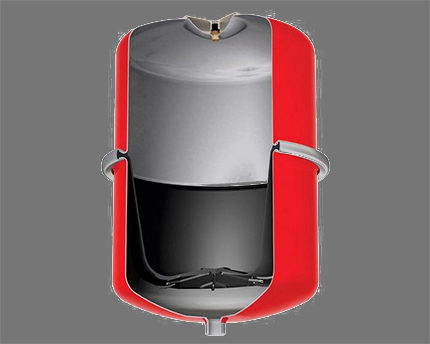
For reliable operation of the device, it is necessary to check air pressure at least once a year
Installing the circulation pump
The necessity of using an additional circulating pump, its parameters are determined by hydraulic engineering calculation. There are several general remarks.
The operation of the circulation pump is designed for a temperature of the order of 60 ° C. Therefore, it is advisable to mount the pump on the back of the pipe, with a cooler coolant. Also for safety reasons, if the coolant overheats to steam, when installing the pump on a straight pipe, the impeller of the pump will stop working, which will lead to even more overheating.
The direction of the coolant flow is clearly marked on the body of the circulation pump. The orientation of the circulation pump can be any, but the rotor should always remain in the horizontal plane.

It is permissible to mount the pump, so that the shaft rotates in the sliding sleeves. Otherwise, the pump will quickly fail
Automatic air vent valves
Even with the formation of air pockets, for the removal of gases, there will be enough one valve. Sooner or later the air will dissolve in the coolant through the valve. However, the rate of dissolution is small and this withdrawal can take up to several months.
The correct setting is only possible on a fully inflated system. In order not to wait several months, several automatic valves must be installed.
A good place to install automatic valves - on the combs and collectors.

The safety valve, pressure gauge, automatic air vent valve makes sense to be mounted together - in the safety block
Site Selection and Collector Installation
The purpose of the collector is distribution of the heat carrier by consumers. Consumers can act warm floors, heating radiators, coils in the bathrooms.
Structurally, the manifold is a section of a pipe with several outlets. The number of bends must correspond to the number of consumers. For a two-pipe system, the number of collectors is at least two. For each tap, the volume of the supplied coolant is regulated.
When organizing the heating of a two-story or more house, a pair of collectors is made for each floor. If there are warm floors, for them it is necessary to allocate a separate collector. There is a couple for each floor. Individual reservoirs are necessary for the following reasons:
- due to the difference in hydrodynamic resistance of pipelines between the nearest and the far radiators of heating;
- at various characteristics of consumers;
- for a reliable setup of the entire system.
Due to the different hydrodynamic resistance, it may be necessary to install an additional circulating pump in the boiler's piping circuit, for example, on a collector of warm floors. For ease of adjustment, collectors are mounted in one place, in a special cabinet.

The collector is an excellent place for mounting auxiliary equipment: pressure gauges, safety valves, flow meters
Selection of pipe material for a single-pipe system
For single-pipe systems, the most common are steel pipes. A large choice of diameters and not high cost make this choice preferable.
When installing pipes, the slope should be at least 5 mm per running meter. Aesthetically inclined pipes look worse, but ensure reliable circulation of the coolant, even if the circulation pump is switched off.
Connection of heating radiators, in an open system, produces a pipe with a minimum diameter of 32 mm. The straight and return lines are made of pipes with a larger diameter, a minimum of 50 mm.

Steel pipes are a practical material, but are prone to corrosion and require painting. Polymer pipes have less hydraulic resistance, therefore smaller diameter can be used
Pipes for a two-pipe system
The two-pipe system does not require large diameters. The pipe material can be various: polypropylene, metal plastic, etc.
The main thing is that pipes can withstand pressure and temperature. Since the two-pipe system does not require natural circulation, the pipes are hidden in underground space or in walls. All pipes must be insulated to prevent heat loss.
Pipes connecting the collector have a diameter of 20-25 mm., Connect heating appliances 16-20 mm. respectively.

The use of modern materials and installation techniques does not require welding. All editing is done as in the designer
Each bending of the pipe adds hydrodynamic resistance, if possible it should be avoided. A big difference in the hydrodynamic resistance of the branches of one reservoir makes it difficult or impossible to regulate.
After mounting all components, pressurization with increased pressure is mandatory. The pressure should remain constant for at least 24 hours. If the heating system has successfully passed the test, the piping of the heating boiler can be considered complete.
How to choose the most suitable heating unit:
Comparative analysis of heating system options:
At first glance, heating systems seem complicated. However, the principles by which the heating system works are very simple. Correctly designed and executed system is able to work for years without any interference.
The heating boiler is a device in which fuel is burnt and the heat transfer fluid is heated. Heat still needs to be fed into the water contours of radiators, a warm floor, a boiler, etc. It is necessary to have a binding scheme - everything that connects it to the appliances in the rooms.
Assignment of strapping
- Maintaining a stable coolant pressure in the system.
- Removing air from the liquid that interferes with its circulation. With the formation of an air stopper, the passage of water through this place ceases. AT the correct scheme air vents are installed.
- Cleaning of the coolant from contamination. Mechanical impurities worsen the operation of the equipment. In this connection, it is necessary to install filters for cleaning.
- Compensation for the temperature expansion of a liquid. In order for the liquid not to destroy the system by excess pressure, a reservoir compensating expansion is installed.
- Connect one or more circuits to the system.
- Accumulation of hot water with a connected boiler.
The simplest circuit with one circuit
The simplest scheme of tying the gas heating boiler is compiled in accordance with its characteristics and requirements.
The strapping also includes connecting the gas supply to the burner.
Tying the gas heating boiler: diagram, photo
The simplest system with one circuit is made in accordance with its characteristics and requirements. From the supply side, the ball valve is also installed.
On the return or pumping pipe, a pump is installed to create a fluid circulation, which ensures a uniform distribution of the heat transfer medium through the rooms. Before it is connected a strainer, located downstream the settler. Before entering the liquid into the boiler, it is advisable to install a fine filter.
Closer to the boiler, an expansion tank of a closed type is installed. In it there is a membrane, allowing to dump superfluous pressure at temperature expansion of a liquid.
After the pump, the coolant flows through the circuit to the radiators. More modern is the decoupling through the collector - a special water collector, from which the liquid is distributed along several contours. It is placed in a separate cabinet, from which the coolant is distributed through pipelines. 
The scheme for tying the gas heating boiler contains a safety valve. When boiling the coolant from overheating, the expansion tank may not cope with the pressure drop. The consequences can be as follows:
- breaks in pipelines and leaks of joints;
- destruction of fittings and pipes;
- explosion of the boiler capacity.
Install as close as possible to the boiler, because it starts to increase pressure.
On some units, safety groups consisting of a relief valve and a manometer are installed. The instruments are mounted directly into the water jacket of the boiler, but can also be installed on pipelines. On gas and electric boilers these devices can be replaced by others, where, when the critical temperature is reached, the burners or electric heaters are switched off.
There are many options for connecting heating equipment to boilers, but the basis for classification is the division into natural and forced circulation.
Natural circulation
The principle of operation is based on a reduction in the specific weight of water when heated. The hot liquid is forced out cold, passes through the heaters, gives off some of the heat and returns to the heating back into the boiler.
The installation of the supply and discharge pipes is carried out with a slope of at least 3 0, so that natural circulation takes place and the air in the system accumulates less.
With natural circulation, the piping of the gas heating boiler (diagram below) is made so that the radiators are located above the supply pipeline. 
The return goes from above also with a slope. When proper installation and the choice of pipe diameters, the natural circulation of power is almost inferior to forced circulation.
Advantages of the method:
- simplicity of the system;
- ease of installation;
- quiet operation;
- durability.
The system is suitable for heating not big house with a total floor space of not more than 100 m 2. The drawbacks include the duration of warming up of premises and the inability of temperature regulation in individual rooms.
Gravitational scheme is used mostly in small houses and in the country, with only one heating circuit. Numerous pipes spoil the interior, if they do not hide in the walls.
Forced circulation
The method has become most common, since the pump pumps through the system a heating medium and the heating efficiency is increased by 30%.
Advantages include the possibility of temperature control and a small flow of pipes during installation. The system is still much more expensive, because it is more complex and requires more devices. The installed elements require balancing, and the entire system - regular service. In addition, a source of electricity is needed.
If you install a combined system, it will combine the advantages of both previous ones. It can be switched to any mode by using the bypass installed with the pump. In this case, the work of heating will not depend on the supply of electricity to the house.
Strapping with polypropylene
Plastic pipes came to replace metal everywhere, including for water pipes. For heating use multilayered reinforced products, high pressure. Thanks to the connections, a monolithic piping of the gas heating boiler with polypropylene is obtained. Schemes are created in any complexity and in a short time. 
Important! The simpler it is, the more reliable it is, and the productivity is higher.
Unlike the coolant, the gas is connected to the boiler through a metal pipe with the gasket sealed and does not burn.
Tying the floor gas heating boiler: scheme
The dimensions of a conventional floor boiler are small, but it takes a lot of space to install it together with the harness. All equipment including a circulation pump, elbows, bushings, manifold, cranes and devices is difficult to place compactly. 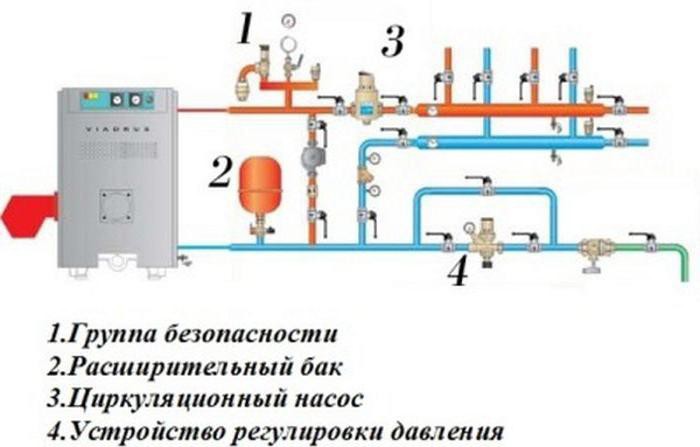
Most models are made single-circuit, and for hot water requires a boiler with all connections.
The hot water supply system requires a separate pump (in the absence of a central water supply), and a thermostatic mixer.
Gas to the boiler must be properly connected. To do this, we order project documentation, which is made up of specialists. Entering the house gas pipe If there is a trip device in the event of an emergency. Gas connect special services, using special pipes, hoses and other equipment.
Wall-mounted boiler installation
Boilers can be hung on the wall even in the kitchen. They take up little space. The piping of the wall gas heating boiler (the diagram below) comes complete and can even be integrated in the boiler. The compact arrangement of equipment requires less space, but similar models are more difficult to maintain. 
The disadvantage of wall-mounted boilers is low power. In addition, the devices do not work without electricity, and the natural circulation of the coolant is rarely used for them. On the other hand, almost all boilers are already equipped with electronics and electricity is necessary for them. In places with its unstable supply it is possible to supply an uninterrupted power supply.
In most wall-mounted models, a double-circuit gas heating boiler is provided, the circuit of which allows the house to be supplied with hot water. 
The drawback of the two-circuit variant is the shutdown of the heating during the consumption of hot water. This is especially noticeable when the boiler capacity is small. If it is enough, the temperature of the coolant drops by only a few degrees within a couple of hours. This applies to houses with high-quality thermal insulation and a sufficient number of radiators with thermal inertia.
Conclusion
The scheme of tying the gas heating boiler is compiled in accordance with its characteristics and requirements. For a summer residence the system of natural circulation through one contour approaches, and for the big house - with compulsory and многоконтурной.
Choosing a dual-circuit boiler for the house, the consumer should understand that this unit is significantly different from a single-circuit one. First, the design. Secondly, by the presence of an additional circuit, which provides the house with hot water for domestic needs. Thirdly, the scheme of tying the gas double-circuit boiler.
The main differences between the two options
Tying the gas boiler
If you compare these two units, it turns out that a single-circuit can also be used to heat water for domestic use. But in this case a separately standing tank - a boiler with a heat exchanger located in it - is connected to the boiler. Hot water for heating passes through this heat exchanger, leaving part of its heat and thereby heating the water.
In the case of a dual-circuit boiler, everything is completely different. Water for domestic needs is heated in the combustion chamber, passing through the second circuit. There are no boilers and other appliances, so heating is done directly without intermediaries. The only point to pay attention to is constructive feature unit and a technological approach to heating water in two circuits. If water starts to be used for domestic needs, it turns off automatically, and the heat carrier in it temporarily does not heat up.
How can this affect the private house heating system and the indoor temperature? If the house is equipped with high-quality thermal insulation, then the question of how the boiler works and how the mode is set does not matter. Periodic disconnection of the heating system will not affect the temperature inside the house, so there is nothing to be afraid of. For example, the fact that for a couple of hours of switching off the temperature inside the house will drop by a maximum of 2-3 degrees. And such a shutdown due to the selection of hot water is very rare.

Scheme of piping of a boiler with a pump
If the house has insufficient thermal insulation, or the building has very large rooms, then the question of the inertia of heat reduction must be addressed in other ways. For example, install more radiators or increase the number of sections. For this it is necessary to select radiators from a material with reduced inertia. Cast iron batteries slowly heated, but also slowly cool. So for such houses it is the best choice. We add that it is possible to reduce the degree of coolant cooling by increasing its volume. Again we return to the radiators and their number, and also take into account the diameter of the piping piping, namely, increase this figure.
And the last. If for some reason the amount of hot water consumed exceeds certain norms by the time indices, it is necessary to revise the option with the purchase of a two-circuit gas boiler. Even optimal scheme strapping here will not help, because such heating can not provide heat to the house without a long heating of the coolant.
Important! Use a dual-circuit boiler in a system with a natural circulation of the coolant is undesirable. The fact is that a decrease in the temperature in the system with the second circuit switched on not only causes a decrease in the temperature in the premises, but also is fraught with difficulties in collecting heat when the first circuit is switched on. Several such trips, and you can forget about a comfortable temperature - it will be distributed unevenly across radiators.
Although such a situation is possible only if the house is installed boiler, made by own hands. Ready-made units go on sale with already built circulating pumps. But to consider the scheme of tying, where natural circulation will be used, is still necessary. After all, it's no secret that power cuts in suburban townships are a common thing. With multi-storey houses there can be problems, but there is not one-story houses. So the owners of these houses are better to install bypasses, cutting off the contour, where the pump is built.
Strapping schemes
In fact, the circuit diagram of a single-circuit boiler does not differ from that of a two-circuit boiler. Yes, this is not necessary. It basically takes into account which boiler will be used - wall or floor. Sometimes the place of installation of the device and its power may affect the tube interchange. But if you correctly calculate and correctly plan the location of the circuits, it will no longer matter, for the wall-mounted boiler is wiring or for the floor.
Let's consider several options related to the size and floor of the house.
One-storey house in a small square
The ideal version of the strapping is the so-called Leningrad bench. This is a single-circuit circuit in the form of a ring, through which radiators are installed. That is, the feed pipe is also a return flow. In the center there is a double-circuit boiler.
What are its advantages?
- Slight consumption of materials.
- Simplicity of the scheme.
- A small coolant flow.

Single-pipe system
Usually such a circuit is used in small houses, where not a lot of people live. And this is a small expense of hot water. Already a plus. But in order to avoid problems, it is better to increase the volume of the coolant by making the system inert. Therefore, it is recommended that larger diameter pipes be used for heating purposes. For example, if you want to install a pipe 40 mm, then you should take 50 mm.
Now, as for the pipe, which removes the coolant from the boiler. Do not mount it horizontally right away. It is necessary to take into account the vertical segment, which experts call the overclock collector. Remember about power outages! Therefore, you need to create a system that can work under a scheme with natural circulation. But after a vertical riser, you can conduct the pipeline horizontally with a slight slope.
And the last thing is the installation of the expansion tank. This must be done necessarily. And the volume of the tank should be 10% of the volume of the coolant.
Two-storey large house

Wiring plan for Baxi double-circuit boiler
It should not be tricky, because the optimal solution is a two-pipe scheme with top filling. That is, from the double-circuit gas boiler, the riser, supplying the heat carrier, rises upward. In the attic, it is divided into contours, which are lowered into the rooms by risers. It is to them that the radiators are connected, but they do not open the riser itself, which is very important. All the risers, having passed two floors, are closed on the reverse circuit, which supplies the coolant to the boiler.
In case of two-story house You can suggest another scheme where two boilers will be used - one on each floor. This simplifies the circuit by dividing it into two separate circuits. We add that this scheme of binding is considered economical in the sense that it is possible to lower the temperature inside the system if one floor - usually the second one - is used by household members seldom.
The universal scheme
If you make a small initial expenditure, then there can be any. That is, it will not affect the efficiency of heating operation so much. To do this, you will have to purchase and install a conventional water-heating boiler with a volume of 200-300 liters. It will play the role of a battery of thermal energy and thereby increase the inertia of the system.
Install such a tank anywhere, connecting it to the circuit. It can be a basement, a place next to the boiler, on the street and so on. Here the convenience of installation and maintenance is important. The tank must be well insulated.
Conclusion on the topic
As you can see, the scheme for connecting a gas dual-circuit boiler is not limited to one option. And even those described are not the ultimate truth. There are many approaches to creating an economically justified heating system. But in the case of a dual-circuit boiler it is necessary to take into account all the nuances mentioned above.

